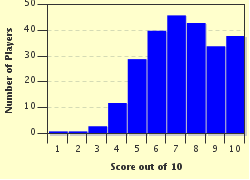Quiz Answer Key and Fun Facts
1. There are 24 ribs in the ribcage, two for each of the twelve thoracical vertebrae. The lower five of them are also called "false ribs". What distinguishes them from the fixed ribs (the upper seven)?
2. Probably the most important thoracic muscle is the diaphragm, a main contributing muscle in the process of respiration. It anatomically separates the thorax from another area of the body. Which one?
3. Given that we all need air in our chest to breathe, a condition called "pneumothorax" (literally: air in the chest) does not sound bad, but it is life-threatening. What is it defined as?
4. Out of the following four major blood vessels, which one exclusively serves organs contained in the thorax?
5. The lungs are a paired organ, but unlike other paired organs, they are not symmetrical. Why is there a significant structural difference between the left and right lung?
6. Anyone who has practiced CPR (cardiopulmonary resuscitation), might have heard of the xiphoid process. What structure is that a part of?
7. The only major organ in the thorax apart from the heart and lungs is the thymus. Which system does it play a major role in?
8. The heart is enclosed in a sac called the pericardium which, while not entirely vital, still serves several important functions. Which is NOT one of them?
9. Aside from blood vessels and the spinal canal, two major passages from the neck extend into (and in one case through) the thorax: the trachea (windpipe) and the esophagus. Where is the trachea located relative to the esophagus in the vast majority of humans?
10. Finally a question about the heart itself - we can't ignore it entirely. The heart receives nervous input from the brain via the vagus and the sympathetic nerve. How do these interact with the heart?
Source: Author
WesleyCrusher
This quiz was reviewed by FunTrivia editor
rossian before going online.
Any errors found in FunTrivia content are routinely corrected through our feedback system.

